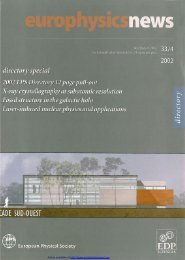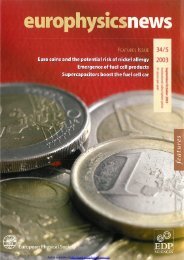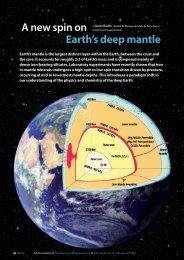Whole issue in PDF - Europhysics News
Whole issue in PDF - Europhysics News
Whole issue in PDF - Europhysics News
You also want an ePaper? Increase the reach of your titles
YUMPU automatically turns print PDFs into web optimized ePapers that Google loves.
FEATURES<br />
Ukra<strong>in</strong>ians and Byelorussians will be far less severe than those<br />
due to addiction to smok<strong>in</strong>g and alcoholism. The Chernobyl disaster<br />
is considered as the archetype of the worst conceivable<br />
civilian nuclear disaster. Nuclear security experts estimate that the<br />
probability that a disaster of this amplitude occur with the reactors<br />
of the type used <strong>in</strong> the West is ofthe order of one millionth<br />
per reactor per year of operation. For France, one of the most<br />
heavily"nuclearised" countries, for <strong>in</strong>stance, this means that such<br />
an event could occur once <strong>in</strong> 20 000 years. Other types of accident~<br />
capable ofcaus<strong>in</strong>g more casualties (dam rupture, explosion<br />
ofa gas tanker, fire or chemical explosion, fall ofa meteorite, trop-<br />
. ical storm, fall ofa large carrierplane, etc.) can occurwith a much<br />
higher probability. Like a nuclear disaster, such accidents would<br />
have local andlor regional consequences but, <strong>in</strong> no way, (except<br />
the fall ofa verylarge meteorite) global. Inno way would the biosphere<br />
be threatened, nor any particular species.<br />
Nuclear waste<br />
It is customary to make the <strong>issue</strong> ofnuclear waste the central reason<br />
to ban any civilian applications of nuclear energy. People<br />
stress the long half-life ofthese wastes, forgett<strong>in</strong>g to mention that,<br />
unlike chemical waste, the dangerousness of nuclear waste is<br />
<strong>in</strong>versely proportional to the life time: the longer the half-life ofa<br />
nucleus, the fewer the dis<strong>in</strong>tegration events per unit time. To what<br />
extent is the radioactivity generated by theses wastes a source of<br />
danger for the biosphere? In the short-term, the radioactivity of<br />
nuclear waste is well conf<strong>in</strong>ed and under control, to the po<strong>in</strong>t<br />
where the <strong>in</strong>cidence onhealth ofthese wastes is t<strong>in</strong>yifnot nil. The<br />
security ofdeep storage would, as is obvious, be much better than<br />
that ofsurface or sub-surface storage. There is general agreement<br />
that, with deep storage, the radioactivity would rema<strong>in</strong> conf<strong>in</strong>ed<br />
for at least one thousand years. Ifwe consider the storage sites as<br />
ly<strong>in</strong>g at depths of500 to one thousand meters, we can compare the<br />
radioactivity that would potentially be released after one thousand<br />
years to that ofthe first thousand meters ofthe earth's crust.<br />
Work<strong>in</strong>g it out (without waste process<strong>in</strong>g or <strong>in</strong>c<strong>in</strong>eration which<br />
would reduce the dangerousness by a factor of 100), aga<strong>in</strong> <strong>in</strong> the<br />
case ofFrance, we f<strong>in</strong>d that the residual radioactivity correspond<strong>in</strong>g<br />
to 100 years ofproduction by 100 plants (at this time, there are<br />
. 57 active nuclear plants <strong>in</strong> France) would be less than one per cent<br />
ofthe crust's natural radioactivity (due to their large size it would<br />
be five times less for the US, for the same level of"nuclearisatiorr').<br />
Thus, we see that deep storage does not represent a danger (barr<strong>in</strong>g<br />
an accident dur<strong>in</strong>g transport) <strong>in</strong> the shortorthe midtermfor<br />
people liv<strong>in</strong>g <strong>in</strong> the vic<strong>in</strong>ity ofthe sites and that, <strong>in</strong> the long term,<br />
it does not represent a risk for the biosphere taken globally. There<br />
could be a risk locally, <strong>in</strong> the case ofan accidental <strong>in</strong>trusion with<strong>in</strong><br />
a given site, by drill<strong>in</strong>g, for example. We should note that,<br />
because ofthe long half-life ofthe wastes still active after a thousandyears,<br />
the products will disperse <strong>in</strong> the biosphere before they<br />
dis<strong>in</strong>tegrate <strong>in</strong> case they are released from their conf<strong>in</strong>ement, limit<strong>in</strong>g,<br />
<strong>in</strong> pr<strong>in</strong>ciple, the local risk. In summary, we reach the same<br />
conclusions that we had come to concern<strong>in</strong>g the characteristics of<br />
nuclear accidents (<strong>in</strong> a less severe way): their <strong>in</strong>cidence is local, at<br />
the most regional and <strong>in</strong> no way global. The difference lies <strong>in</strong> the<br />
time scale and, here aga<strong>in</strong>, a bit of common sense would tend to<br />
conv<strong>in</strong>ce us that, all th<strong>in</strong>gs equal, a risk that may arise one to ten<br />
thousand years from now is preferable to a risk which threatens<br />
today or <strong>in</strong> the com<strong>in</strong>g century.<br />
Proliferation<br />
The base materials used to manufacture nuclear explosives are<br />
Uranium 235 and Plutonium 249. Uranium 235 is present <strong>in</strong> nateurophysics<br />
news MARCH/APRIL 2001<br />
ural Uranium <strong>in</strong> a proportion of0.7% while the concentration of<br />
this isotope that is needed to make a bomb is 90%. It follows that<br />
isotopic enrichment procedures are required. Up until the seventies,<br />
the two procedures that were available, electromagnetic<br />
separation, and gaseous diffusion, were cumbersome, expensive,<br />
and heavy electricity consumers. Today, two new techniques are<br />
available, that are lighter and less conspicuous: gaseous centrifugation<br />
and laser separation. By us<strong>in</strong>g these different techniques,<br />
any country that has the human competence and a m<strong>in</strong>imum of<br />
means is able to produce enough highly enriched Uranium 235 to<br />
manufacture several bombs. That is what Pakistan has done<br />
recently and what Iraq was <strong>in</strong> the process of do<strong>in</strong>g. Iraq did not<br />
have a nuclear reactor. Pakistan had a reactor ofthe type used <strong>in</strong><br />
Canada but did not use it to produce the fissile material it needed<br />
for its first bombs.<br />
The other fissile material, Plutonium 249, is produced <strong>in</strong><br />
nuclear reactors. All reactors that operate with Uranium, whether<br />
natural or slightly enriched, produce Plutonium that can be relatively<br />
easily extracted us<strong>in</strong>g chemical procedures. The truth is that<br />
none ofthe military nuclear powers acquired the status ofnuclear<br />
power by us<strong>in</strong>g nuclear reactors built with a view to generat<strong>in</strong>g<br />
electricity. The transfer from civilian nuclear to military nuclear<br />
activityhas not, to ourknowledge, ever occurred. Onthe contrary,<br />
the <strong>in</strong>verse transfer, from the military to the civilian sphere has<br />
beenfrequent andexpla<strong>in</strong>s some ofthe characteristics ofthe civilian<br />
nuclear <strong>in</strong>dustry that might not have been true <strong>in</strong> other<br />
circumstances: for example us<strong>in</strong>g enriched Uranium <strong>in</strong> water<br />
cooled plants. It is true, also, that some militarynuclear powers, or<br />
powers that <strong>in</strong>tended to become such, handled nuclear power<br />
reactors <strong>in</strong> such a way as to extract high quality Plutonium from<br />
them Itwas the case <strong>in</strong> France, with its graphite-gas reactors, and<br />
<strong>in</strong> the Soviet Union with its RBMK reactors (Chernobyl type). In<br />
reality, the countries wish<strong>in</strong>g to equip themselves with commercial<br />
power reactors have to sign a non-proliferation treaty and,<br />
thus, renounce any development ofnuclear weapons.<br />
We see, then, that as far as States are concerned, the fear ofsee<strong>in</strong>g<br />
civilian nuclear power plants be diverted towards military<br />
ends has been futile until now. The States that have decided to<br />
acquire nuclear weapons have been able to do so, provided they<br />
had the human competence (physicists, eng<strong>in</strong>eers) and the material<br />
means. As for terrorist groups liable to practice nuclear<br />
blackmail, we should consider that the demise ofthe Soviet Union<br />
has, alas, already given them the means to acquire the needed<br />
goods.<br />
Risks with fossil fuels<br />
We won't dwell, here, on the dangers due to the production, the<br />
transportation and the use offossil fuels: accidents <strong>in</strong> coal m<strong>in</strong>es,<br />
fires <strong>in</strong> pipel<strong>in</strong>es (5 000 death casualties <strong>in</strong> Nigeria a few years<br />
ago), explosions <strong>in</strong> gas pipes (Siberia, Mexico) and, ofcourse, concern<strong>in</strong>g<br />
gas, domestic explosions (100 death casualties per year <strong>in</strong><br />
France) - these are well known. Likewise, we will not dwell on oil<br />
slicks, the environmental impactdue to work<strong>in</strong>g the far North, the<br />
wars triggered by the will to control resources and pipel<strong>in</strong>es<br />
(Biafra, Kuwait, Chechnya, Angola, etc.). All these dangers, all<br />
these wars related to the use offossil fuels, however dramatic and<br />
deadly (much more so than the Chernobyl disaster!) rema<strong>in</strong> circumscribed<br />
to the local or regional level and do not threaten the<br />
biosphere itself, barr<strong>in</strong>g the extension of regional conflicts to a<br />
world conflict.We will set our argument on the emission ofgreenhouse<br />
gases.<br />
The use of fossil fuels <strong>in</strong>duces the emission of greenhouse<br />
gases: carbon dioxide generated by combustion, <strong>in</strong> vary<strong>in</strong>g<br />
53










